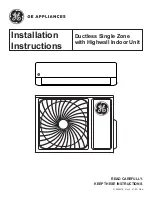
En-4
4-1. PURGING PROCEDURES AND LEAK TEST
3-2. PIPE CONNECTION
1) Apply a thin coat of refrigeration oil (G) to the flared ends of the pipes and the pipe connections of the outdoor
unit.
2) Align the center of the pipe with that of the pipe connections of the outdoor unit, then hand tighten the flare
nut 3 to 4 turns.
3) Tighten the flare nut with a torque wrench as specified in the table.
• Over-tightening may cause damage to the flare nut, resulting in refrigerant leakage.
• Be sure to wrap insulation around the piping. Direct contact with the bare piping may result in burns or frostbite.
3-3. INSULATION AND TAPING
1) Cover piping joints with pipe cover.
2) For outdoor unit side, surely insulate every piping including valves.
3) Using piping tape (E), apply taping starting from the entry of outdoor unit.
• Stop the end of piping tape (E) with tape (with adhesive agent attached).
• When piping have to be arranged through above ceiling, closet or where the temperature and humidity are
high, wind additional commercially sold insulation to prevent condensation.
1) Remove service port cap of stop valve on the side of the outdoor unit
gas pipe. (The stop valves are fully closed and covered in caps in
their initial state.)
2) Connect gauge manifold valve and vacuum pump to service port of
stop valve on the gas pipe side of the outdoor unit.
3) Run the vacuum pump. (Vacuumize for more than 15 minutes.)
4) Check the vacuum with gauge manifold valve, then close gauge
manifold valve, and stop the vacuum pump.
5) Leave as it is for one or two minutes. Make sure the pointer of gauge
manifold valve remains in the same position. Confirm that pressure
gauge shows -0.101 MPa [Gauge] (-760 mmHg).
6) Remove gauge manifold valve quickly from service port of stop valve.
7) Fully open all stop valves on the gas pipe and the liquid pipe. Operating
without fully opening lowers the performance and this causes trouble.
8) Refer to 1-2., and charge the prescribed amount of refrigerant if
needed. Be sure to charge slowly with liquid refrigerant. Otherwise,
composition of the refrigerant in the system may be changed and
affect performance of the air conditioner.
9) Tighten cap of service port to obtain the initial status.
10) Leak test
WARNING
When installing the unit, securely
connect the refrigerant pipes before
starting the compressor.
CAUTION
When there are the ports which are
not used, make sure their nuts are
tightened securely.
Stop valve
for GAS
Stop valve
cap (Torque
19.6 to 29.4
N•m, 200 to
300 kgf•cm)
Gauge manifold
valve (for R410A)
Compound pressure
gauge (for R410A)
–0.101 MPa
(–760 mmHg)
Handle
Low
Handle High
Vacuum pump
(for R410A)
*Close
*Open
Hexagonal wrench
*4 to 5 turns
Stop valve
for LIQUID
Pressure gauge
(for R410A)
Precautions when us
-
ing the control valve
When attaching the control valve
to the service port, valve core may
deform or loosen if excess pres
-
sure is applied. This may cause
gas leak.
Service
port
Charge hose
(for R410A)
Body
Close
Open
Control
valve
A
When attaching the control valve to
the service port, make sure that the
valve core is in closed position, and
then tighten part A. Do not tighten
part A or turn the body when valve
core is in open position.
Service port cap
(Torque 13.7 to 17.7
N•m, 140 to 180 kgf•cm)
Charge hose
(for R410A)
4-2. GAS CHARGE
Perform gas charge to unit.
1) Connect gas cylinder to the service port of stop valve.
2) Perform air purge of the pipe (or hose) coming from refrigerant gas cylinder.
3) Replenish specified amount of the refrigerant, while operating the air conditioner
for cooling.
Note:
In case of adding refrigerant, comply with the quantity specified for the refrigerat
-
ing cycle.
CAUTION:
When charging the refrigerant system with additional refrigerant, be sure to use
liquid refrigerant. Adding gas refrigerant may change the composition of the refriger
-
ant in the system and affect normal operation of the air conditioner. Also, charge
the liquid refrigerant slowly, otherwise the compressor will be locked.
To maintain the high pressure of the gas cylinder, warm the gas cylinder with
warm water (under 40°C) during cold season. But never use naked fire or steam.
Refrigerant gas
cylinder
operating valve
(for R410A)
Indoor
unit
Charge hose (for R410A)
Refrigerant gas cylinder
for R410A with siphon
Electronic scale for
refrigerant charging
Refrigerant (liquid)
Indoor
unit
Union
Union
Liquid pipe
Gas pipe
Liquid pipe
Gas pipe
Stop valve
Service port
Outdoor
unit
Gauge manifold
valve (for R410A)
4. PURGING PROCEDURES, LEAK TEST, AND TEST RUN
BH79A129H01_en.indd 4
10/31/2014 9:57:27 AM
























